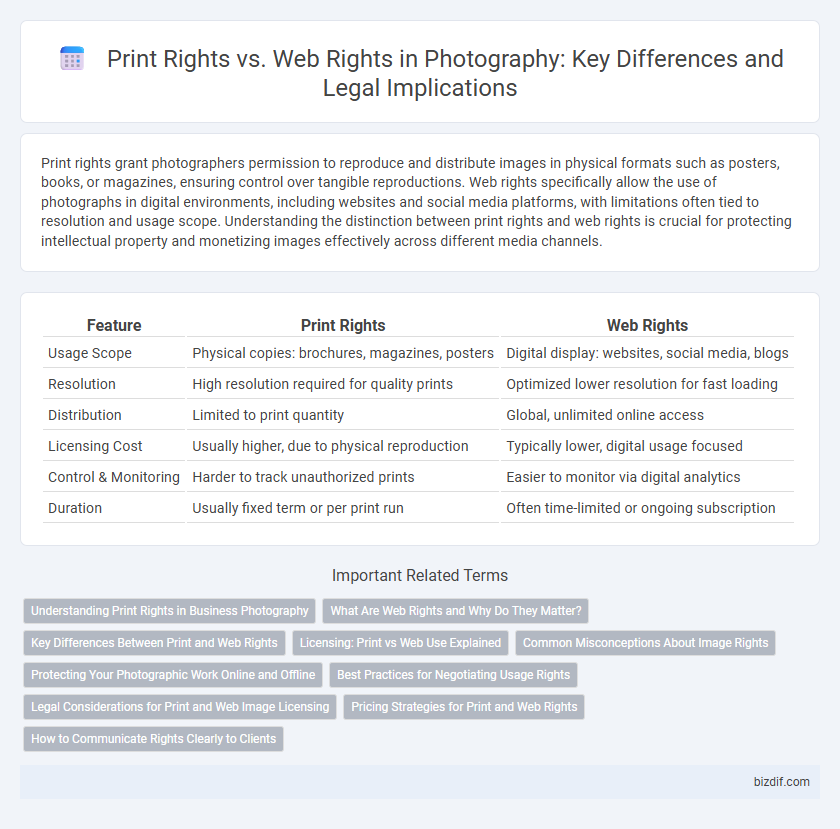Print rights grant photographers permission to reproduce and distribute images in physical formats such as posters, books, or magazines, ensuring control over tangible reproductions. Web rights specifically allow the use of photographs in digital environments, including websites and social media platforms, with limitations often tied to resolution and usage scope. Understanding the distinction between print rights and web rights is crucial for protecting intellectual property and monetizing images effectively across different media channels.
Table of Comparison
| Feature | Print Rights | Web Rights |
|---|---|---|
| Usage Scope | Physical copies: brochures, magazines, posters | Digital display: websites, social media, blogs |
| Resolution | High resolution required for quality prints | Optimized lower resolution for fast loading |
| Distribution | Limited to print quantity | Global, unlimited online access |
| Licensing Cost | Usually higher, due to physical reproduction | Typically lower, digital usage focused |
| Control & Monitoring | Harder to track unauthorized prints | Easier to monitor via digital analytics |
| Duration | Usually fixed term or per print run | Often time-limited or ongoing subscription |
Understanding Print Rights in Business Photography
Print rights in business photography grant clients permission to reproduce images in physical formats such as brochures, magazines, and promotional materials. These rights are typically negotiated separately from web rights, which cover digital display on websites and social media platforms. Understanding the scope of print rights ensures proper usage, avoids copyright infringement, and aligns with licensing agreements for commercial use.
What Are Web Rights and Why Do They Matter?
Web rights refer to the permissions granted to use photographs specifically on digital platforms such as websites, social media, and online advertisements. These rights control how images are displayed, reproduced, and distributed online, ensuring photographers retain control over their work and receive appropriate compensation. Understanding web rights is crucial for both photographers and clients to prevent unauthorized use and protect intellectual property in the digital space.
Key Differences Between Print and Web Rights
Print rights grant the licensee permission to reproduce images in physical formats such as magazines, brochures, or posters, often requiring higher resolution files and specific usage terms, including territory and duration. Web rights authorize the use of images exclusively for digital platforms like websites, social media, or online advertisements, with considerations for screen resolution and file compression to optimize load times. Licensing fees and restrictions typically differ, reflecting the distinct exposure, reproduction quality, and distribution scope associated with print versus web usage.
Licensing: Print vs Web Use Explained
Print rights grant permission to reproduce a photograph in physical formats such as magazines, posters, or brochures, typically involving higher fees due to broader usage and distribution. Web rights specifically allow image use on digital platforms like websites and social media, often limited by resolution and display scope to protect against unauthorized print reproduction. Understanding these licensing distinctions ensures photographers control image usage while clients secure appropriate rights aligned with their marketing channels.
Common Misconceptions About Image Rights
Print rights and web rights are often confused, but they govern distinct uses of a photograph, with print rights allowing physical reproductions like magazines and posters, while web rights cover digital display on websites and social media. A common misconception is that purchasing one type of right grants unlimited use across all media, which can lead to unauthorized usage and legal issues. Photographers and clients must clearly specify and negotiate these rights separately to avoid infringement and ensure proper compensation.
Protecting Your Photographic Work Online and Offline
Print rights grant control over physical reproductions of photographs, allowing photographers to regulate usage in books, magazines, and other tangible media. Web rights specifically pertain to digital distribution, limiting or permitting how images are displayed, shared, or altered on websites and social platforms. Securing both print and web rights is essential for comprehensive protection, ensuring photographers maintain ownership and control over their work in both offline and online environments.
Best Practices for Negotiating Usage Rights
When negotiating photography usage rights, clearly distinguish between print rights and web rights to avoid misunderstandings about distribution channels. Specify the duration, geographic scope, and exclusivity for each right, tailoring agreements to the intended use such as magazines, billboards, or social media. Establishing detailed contracts with explicit usage limitations safeguards both photographers' intellectual property and clients' marketing strategies.
Legal Considerations for Print and Web Image Licensing
Print rights grant clients permission to reproduce images in physical formats like magazines, brochures, or billboards, requiring clear licensing terms to specify usage scope, duration, and geographic limits to avoid legal disputes. Web rights typically restrict image use to digital platforms, often including specific resolution and display constraints to prevent unauthorized commercial exploitation or redistribution. Understanding the distinction and explicitly defining print versus web licensing in contracts protects photographers' intellectual property and ensures clients comply with legal frameworks governing image use.
Pricing Strategies for Print and Web Rights
Pricing strategies for print rights typically involve higher fees due to the physical reproduction and limited runs associated with printed materials, reflecting factors like exclusivity, distribution scale, and print quality. Web rights pricing tends to be more flexible and often lower, accounting for digital display, wider but non-exclusive access, and usage duration on websites or social media platforms. Photographers and licensors strategically structure these pricing tiers to balance revenue generation with market demand, usage limitations, and potential audience reach for both print and web applications.
How to Communicate Rights Clearly to Clients
Clearly define print rights and web rights in the photography contract by specifying the allowed usage types, duration, and geographic scope. Use plain language to explain limitations such as resolution restrictions for web use and exclusive print distribution rights to prevent unauthorized reproduction. Provide clients with written examples highlighting scenarios to ensure mutual understanding and avoid legal disputes over image usage.
Print Rights vs Web Rights Infographic

 bizdif.com
bizdif.com